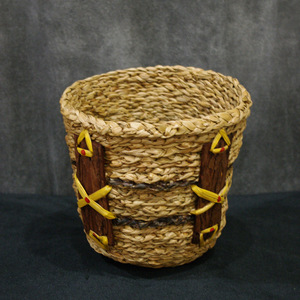

One of John Robbins' cattail baskets (photo by Dean Barr)
John Robbins has been involved in art his entire life. "I've always been a painter and sculptor and devoured information about art since childhood." He describes his early artistic self as an abstract expressionist.
But in the early "80s, his artistic life took a turn because of "just one more beer." He was in Maryville, Tennessee, where his girlfriend lived and worked. He and some friends had gone to the Great Smoky Mountains Park and were staying in Townsend, Tennessee, outside the park. They went out for a beer, and his friends went home early.
"I was going to have just one more. There were a couple of American Indians, Cherokees, there. Drinking beer makes my tongue loose, so I went over and talked to them. Native Americans are always intriguing. Their whole family made baskets and always had. Being an arrogant abstract expressionist, I thought "baskets, smaskets,' but as I spent time with them, I became fascinated with them. I've always loved the outdoors, but I began to see nature through new eyes," he says.
The Cherokee family taught Robbins basketry, which he continues to practice. "They used honeysuckle, river willows and river cane. Everything was so stiff and brittle, and difficult to work with. But they could work with it. I walked every night on the trails in the green space in Maryville. One night I picked a cattail and started messing with it. When I first laid my hands on it, I knew it was my destiny. I was a goner.
"By hand gathering materials from the wild and carefully constructing each basket in a time-honored fashion, I perpetuate a tradition that stretches back to civilization's earliest beginnings. Each vessel is created of sun-dried cattail rushes (typha latifolia) and sealed with the oils and earth pigments. They will last for generations," he says.
Robbins creates his baskets with simple tools – a chef's knife to cut the cattails, scissors and large needles. He gathers his own cattails, then spreads them on a tarp in the sun for three days and then puts them up like hay. He's been collecting his own cattails since he began making baskets. He says that when gathering locally, he has to keep an eye out for snakes. But when he was living in Washington, D.C., he had to keep an eye out for different problems, such as "crack heads."
He likes cattails because he prefers a nice clean surface, although he will use other materials. He was once commissioned to make a basket out of ground cedar, which he says has a skin like a "potato." He also uses grape vines sometimes, even though the tendrils are troublesome. He has a grapevine sculpture that's "as big as a car" in front of Dr. James Schrenker's office on Midway Street in Bristol, Virginia. "I can't do something like that every day. It was like fighting a boa constrictor," Robbins says.
He also created an 11-foot tall obelisk for the William King Museum of Arts' Egyptian art exhibit. He built it out of hickory. The central reeds of cattail are like dowel rods. He used them to sew an 11-foot mat of cattails and created hieroglyphics. He still paints and sculpts, but says that is primarily for therapy and preparation for creating his baskets.
"I feel whole when I'm interacting with the cattails and the environment. I'm surrounded by redwing blackbirds, and the wind is blowing, and it looks like the Bolshoi Ballet, and I'm knee deep in mud. The urban environment doesn't agree with me any more. There's too many people, too much noise and too many distractions. The green hills of home always call the boy from the hills back home." he says.
Robbins uses his back yard as a shopping center and source of inspiration. His yard backs up to the forest and adjoins Steele's Creek in Bristol, Tennessee. He roams through the yard to get bark, wood and other items, which he uses to embellish his baskets.
"I have a flat river rock terrace a few feet inside the woods that I built years ago. I spend all my time up there. I don't compose against a blank wall. I work where I can see the woods. It stimulates the imagination," he says.
"There isn't a time that basketry isn't very interesting. Ever since that epiphany with the Indians and the basketry, I've been seeing nature even clearer. They knew that instinctively.
"Basketry is a direct link to the most ancient world. It's gratifying to have links to something that old. It keeps ancient crafts from dying. Primitive people saw the world in different ways than modern people do to a degree.
"I draw my strength from nature, so it's perfect living in a place like this near Bristol where I'm surrounded by the beauty of nature," he says.
Robbins' baskets can be seen at The Gallery @ Barr Photographics in Abingdon, Virginia.
BACK TO THE MAIN STORY
Maiorana creates flowing metal artwork